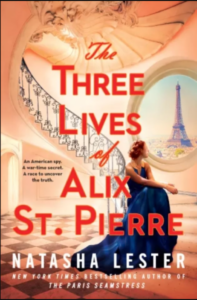Natasha Lester writes lush, atmospheric, and richly detailed historical novels; her latest, The Three Lives of Alix St. Pierre, takes us into the Parisian fashion world during WWII, as the glamorous Alix St. Pierre takes a job at the fashion house of Dior and starts moonlighting as an American spy. I caught up with Natasha Lester over email to chat about the book, historical research, and the timeless allure of mid-century fashion.
Women in espionage have been having a moment, in fiction and in nonfiction. What’s responsible for the rise in interest in women spies, do you think?
Their stories have been left out of the history books for so long, which means it’s wonderful to finally see their achievements, their bravery and their work being written about. And I think that’s what readers enjoy – the sense that at last we’re seeing how much women contributed to past victories. And who wouldn’t find a story about a badass lady spy like Alix St Pierre fascinating?!
Tell us about the research you did for the novel.
I read Autobiography of a Spy by Mary Bancroft, who worked as a spy for the US government in Switzerland during WWII. Who knew there were spies in neutral Switzerland during the war, and that one of them was a woman? I didn’t, and as soon as I found that out, I knew Mary needed to be a character in my book, working alongside Alix. I read all of the cables sent from the Swiss station of OSS, where Mary worked during the war. It was slow work but I found some gems in there that definitely enhanced my book. For some more personal perspectives, I read the memoirs of the Italian staffette, the women who helped the Italian partisans survive in the Italian Alps during the Nazi Occupation of Italy. And I travelled to both Switzerland and Italy where the book is set so I could bring those locations to life in my writing.
Who are some of the real life figures who inspired your story?
As I’ve already mentioned, Mary Bancroft was a real woman who features in the story. But there’s also couturier Christian Dior, as well as the four incredible women who held the most senior positions in the couture house and who helped make Dior the icon he was – and still is today. And Carmel Snow, inimitable fashion editor for Harper’s Bazaar, makes a couple of appearances, as does Allen Dulles, former head of the OSS Switzerland station and ex-director of the CIA. I love to populate my books with real people because true events are often more interesting than fictional ones, especially when you’re looking at the legacies that war leaves behind in people’s hearts and minds, and in our culture.
Before turning to writing, your expertise was firmly established in fashion. What was it like to immerse yourself in fashion once again, but through a fictional perspective?
I think that if you write about what you love, the reader can feel that love. Describing a Dior gown from 1947 is both a part of the story, a joyful experience for me, a chance for the reader to go googling that particular dress so they can see pictures of it (and they do!) and a way to bring the characters to life. Fashion isn’t just fashion – it’s a way to blend in, a way to stand out, a way to rebel, a way to conform and a way to be someone else.
If you could pick a few fashion trends to come back from the 1940s (terrible time in history, great time in fashion), what would you pick and why?
The extravagant ballgown. Unfortunately, we just don’t have the occasions to wear these kinds of dresses anymore. Alix St Pierre wears a particular Dior ballgown called Compiègne in the story and to spend a night twirling in that would be quite something.
You collect vintage fashion – what are the periods in history most represented in your closet?
I have a few pieces from the 1950s. I especially love American designer Claire McCardell’s 1950s sundresses. I would love to purchase a Dior New Look piece, but at tens of thousands of dollars, they’re a little out of my price range!
Your writing is richly textured when it comes to the feel of the past, not just the facts. How do you go about immersing your readers in your chosen eras?
One of the most important parts of research for any historical novel is reading memoirs. That’s where people tell you how they felt, not just the facts. Then you can describe what it was like to hike in midwinter across the Swiss-Italian border in the middle of the night, trying to evade the Nazis, in a way that feels real. You can paint a picture with words about what exactly the Piscine Deligny (a swimming pool that floated on the Rivier Seine in Paris) looked like one night in 1947 when it was transformed into the setting for a grand Venetian Ball. You can bring to life the sadness and shame that lingered on the streets of Paris in late 1946 as people tried to put the terrible wartime years behind them.
***


















